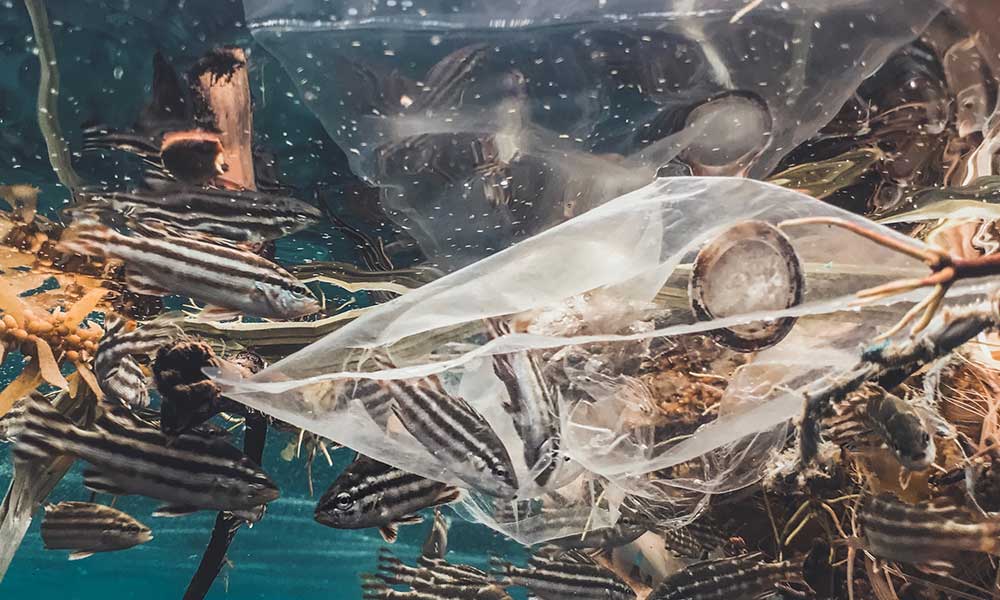Why Is There Plastic In The Ocean?
One of the main reasons there is plastic in the ocean is because it’s present on the land and blows into the water.
The wind causes the household and commercial waste to blow out of trash bins and landfills and into nearby sewers and rivers.
80 percent of the plastic that is currently in the ocean comes from land-based activities and isn’t primarily due to waste that is tossed out from boats.
90 percent of the waste enters the water after it’s flushed through rivers and due to littering.
Beach visitors, illegal dumping, industrial activities, and poor waste disposal and management all contribute to the increase in waste in the water.
Plastics currently make up 80 percent of all marine waste in the ocean.
How Much Plastic Was In The Ocean 2020?
In 2020, there was 30 percent more waste than the previous year in 2019.
There was a total of 8 million tons of plastic in the ocean.
This would be like a garbage truck of plastic dumping waste into the ocean each minute.
By 2050, it’s expected that there will be more trash than fish in the ocean.
How Much Plastic Was In The Ocean In 2019?
In 2019, it was reported that there were approximately 5.25 trillion pieces of plastic debris in the ocean.
During this time, 269,000 tons of waste floated directly on the surface of the water.
There were also four billion plastic microfibers for every square kilometer of litter in the deep sea.
About 8 million pieces of plastic enter the ocean every day.
How Does Plastic Ends Up In The Ocean?
There are many ways that plastic ends up in the ocean each year.
Wastewater that is drained into the ocean often carries a lot of trash, mainly single-use plastics like bags, straws, wrappers, and cotton buds.
These items are designed to be tossed out after they’re only used one time.
Because these plastics are lightweight, it’s easier for them to travel into the ocean when they’re picked up by the wind.
Multi-use plastic items are also present in the ocean but don’t end up in the water as frequently as single-use plastic products.
The trash from the land also ends up in rivers, which causes it to be transported directly into the ocean.
A lot of recycled plastic also ends up in the ocean due to inadequate operations at informal processing facilities.
Different types of plastic that are washed down the drain also end up in the ocean, which includes wet wipes and sanitary products.
Even small microfibers from our clothes that we wash in our washing machines travel to the ocean. This is because the fibers are too small to be filtered by waste water plants.
Many small marine animals end up eating the fibers, causing them to enter our food chain.
Small plastic microbeads in different types of cosmetic products also get washed down the drain and enter the ocean.
Throwing plastic in a trash bin outside in a public setting can also cause it to get into the ocean when it could have been recycled.
The trash is lightweight, which causes it to be lifted up into the air and then into the water.
Littering is another contributing factor. When people toss out their waste on the streets or in public settings, it’s prone to blowing away and can end up in streams and rivers, eventually landing in the ocean.
How Many Tons Of Plastic Is In The Ocean?
There are currently 269,000 tons of plastic present in the ocean and 46,000 pieces of trash every square mile. Eight to 10 million tons of plastic enter the water each day.
How Many Plastic Bags Are In The Ocean?
There are currently an estimated 1 trillion plastic bags present in the ocean, which equates to 100 million barrels of oil.
Approximately 10 percent of plastic bags end up in the ocean after they’re discarded.
20 percent of the plastic bags come from boats and different off-shore platforms.
Unfortunately, the plastic takes thousands of years to decay, even when it’s submerged underwater. Fish and wildlife often get stuck in the plastic bags, which often leads to death.
The fish also become contaminated by the toxins and chemicals.
How Does Plastic In The Ocean Affect Humans?
The plastic that is present in the ocean is often consumed or absorbed by the marine life, which ends up in our food chain.
This can threaten human health as different chemicals are released into the water.
Humans ingest the chemicals that are consumed by fish and different types of marine life.
The toxins that are detected are linked to cancer, birth defects, childhood development issues, and immune system problems.
How Does Plastic In The Ocean Affect Sea Life?
All plastic that is present in the ocean causes many types of fish, birds, and marine life to become entangled in the waste. Many types of animals suffocate, drown, and starve after becoming entangled or ingesting the plastic pieces.
Sea turtles are known to ingest different types of plastic, which causes them to starve when the waste doesn’t digest.
Thousands of birds and sea creatures die every year as a result of contact with different types of plastic materials.
Research shows that plastic also destroys certain habitats and mating rituals, which has an effect on the populations of different types of species.
In severe cases, it can wipe out entire species.
How Many Plastic Bottles Are In The Ocean?
It’s estimated that over 50 billion plastic water bottles are currently present in the ocean.
8 million tons of plastic bottles get into the ocean every year, causing the waters to become even more littered over time.
Plastic water bottles that are discarded in outdoor waste bins tend to blow away and end up in the ocean because they’re lightweight when they’re empty.
They’re often carried by stormwater into the ocean.







